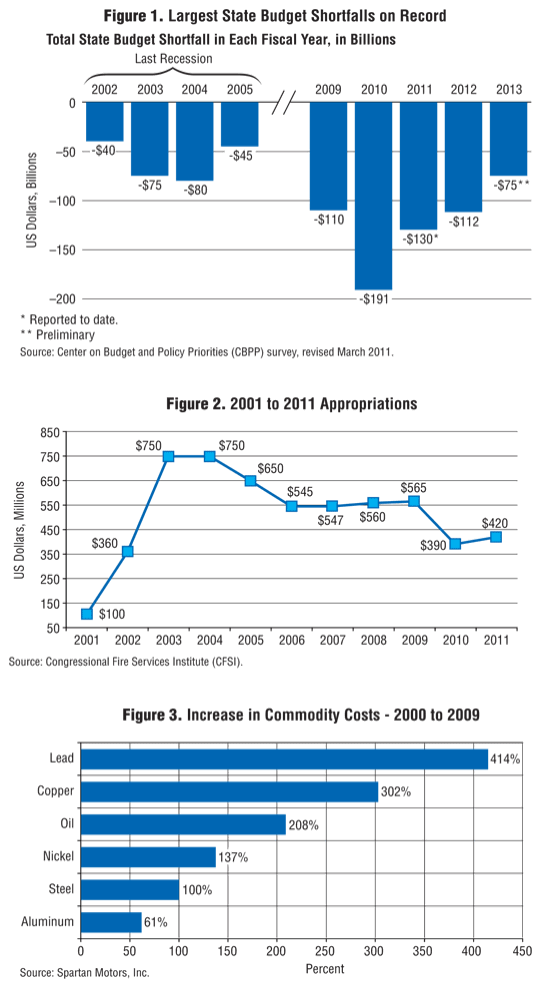By John E. Sztykiel
President and CEO
Spartan Motors, Inc.
The state of the emergency response industry today is very challenging. Money is tight; there have been layoffs; cities are consolidating services; firehouses are being closed; and industry purchases of equipment, services, and apparatus are down.
Consider the following:
1. Reduced state and municipal budgets–with unemployment at its highest level since the great depression, tax revenues are down substantially (Figure 1).
2. There has been a reduction in Assistance to Firefighter Grant (AFG) funding (Figure 2).
3. Prices for equipment, service, and apparatus continue to rise as commodity costs continue to increase (Figure 3).
The fire truck market is forecast to be substantially lower in 2011 and 2012, and this will only contribute to the already huge problem of having too many very old fire trucks in service today (54 percent of all fire trucks in service today are more than 15 years old).
The Need Is There … and Growing
There is a call for help every 0.73 seconds. Over time, that number will decrease as call frequency increases. This is due, in part, to an aging population as 11,000 people turn 50 daily. The tough reality is that more of us will take a ride in an emergency response product whether we want to or not. Financial loss per building is up 32 percent (1992 to 2007). Medical-aid calls are up 244 percent. Finally, a fire department is the first point of call for a negative incident.
This challenging environment will ultimately force major paradigm shifts in the manner in which the industry operates–from its product, to the manner in which its services are performed, to the departments and how they operate.
There will be a huge focus on “lowering the operating cost of a vehicle” and “lowering the acquisition cost of the vehicle by enabling it to respond to a greater number of runs.” In essence, the industry will manage time and space more effectively and efficiently. While the industry does a great job saving lives and protecting property today, we will be a far different industry three, five, and ten years out.
Time and Space
Let’s briefly discuss the importance of time. The reality is that the more quickly a department responds to a call, the greater the opportunity for a positive outcome. Human life can be over or severely affected in a matter of seconds. There are numerous response time standards (NFPA, American Red Cross, and so on), and our industry challenge is to meet or exceed these standards while reducing the cost point.
Below are examples of “time usage” areas with an emergency response fire department. I have no doubt there are more, but as one can see, it is a lot more than just showing up at the scene.
| Time |
| • Training |
| • Shift sequence |
| • Call preparation at the firehouse |
| • Pre-call preparation while in transit |
| • Deployment at the scene |
| • Scene activity |
| • Scene close down |
| • Post-call transit back to firehouse |
| • Post-call analysis |
| • Vehicle cleanup |
| • Data management of activities |
| • Scene activity |
Now, think about “space.” Below are examples of space utilization.
| Space |
| • At the firehouse |
| • On the vehicle |
| • Equipment or apparatus on vehicle |
| • At the scene |
| • At partnering firehouses/departments |
| • At local dealerships that serve the department/firehouse |
| • At OEMs that service the industry |
Robert Tutterow’s March 2011 “The Fire Service as ‘Budget Bait’ ” is forward looking, right on, and a challenge to all of us.
Products, services, and the manner in which the industry operates will change dramatically as we manage time and space more effectively and efficiently to save lives and property. Products will be smaller, be built with different material, be multifunctional, be lower in cost to operate, and transmit large amounts of usage/operational data. Replacement parts, apparatus, tools, gear, and so on will become a just-in-time event to be stocked at the dealer or the OEM rather than at the firehouse or department. There will be tremendous change.
These outcomes will create demand to drive the industry past its peak of 6,000 units. Another added benefit is that the number of apparatus greater than 15 years old will decline. It is unsettling to think about how many emergency response vehicles are in service today without antilock brakes or with open backend cabs.
This philosophical paradigm shift has happened, or is happening, in communications, the steel and auto industries, transportation of packages, and trucking. Lack of funds was the primary driver of the paradigm shift. Each industry has come out strong, and the consumer has benefited, and the same will happen in the emergency response market. The only negatives are the trials and tribulations of going through the current time period.
In closing, the need is there and growing. Our industry is about life and preserving all it encompasses. These challenges will create opportunity, and, as we evolve, tomorrow will be much brighter than today for all stakeholders.
JOHN E. SZTYKIEL has been president and chief executive officer of Spartan Motors, Inc. since 2002. He has been with the company since 1985, serving in a number of operations, sales, and marketing positions during his tenure, including president and chief operating officer from 1992 until 2002. He has been a director since 1988. He is a past president of the Fire Apparatus Manufacturers Association (FAMA) board.
More Fire Apparatus Current Issue Articles
More Fire Apparatus Archives Issue Articles


